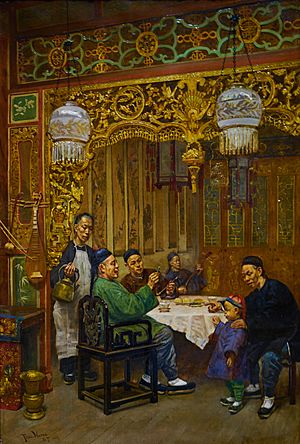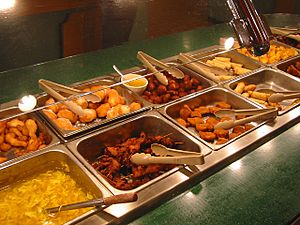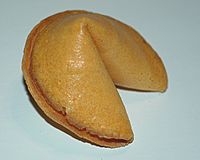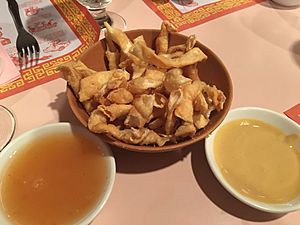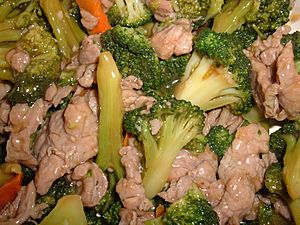American Chinese cuisine facts for kids
American Chinese cuisine is a style of Chinese cuisine developed by Chinese Americans. The dishes served in many North American Chinese restaurants are adapted to American tastes and often differ significantly from those found in China.
Contents
History
Chinese immigrants arrived in the United States seeking employment as miners and railroad workers. As larger groups arrived, laws were put in place preventing them from owning land. They mostly lived together in ghettos, individually referred to as "Chinatown". Here the immigrants started their own small businesses, including restaurants and laundry services.
By the 19th century, the Chinese community in San Francisco operated sophisticated and sometimes luxurious restaurants patronized mainly by Chinese. The restaurants in smaller towns (mostly owned by Chinese immigrants) served food based on what their customers requested, anything ranging from pork chop sandwiches and apple pie, to beans and eggs. Many of these small-town restaurant owners were self-taught family cooks who improvised on different cooking methods using whatever ingredients were available.
These smaller restaurants were responsible for developing American Chinese cuisine, where the food was modified to suit a more American palate. First catering to miners and railroad workers, they established new eateries in towns where Chinese food was completely unknown, adapting local ingredients and catering to their customers' tastes. Even though the new flavors and dishes meant they were not strictly Chinese cuisine, these Chinese restaurants have been cultural ambassadors to Americans.
Chinese restaurants in the United States began during the California Gold Rush, which brought 20,000-30,000 immigrants across from the Canton (Guangdong) region of China. By 1850, there were five Chinese restaurants in San Francisco. Soon after, significant amounts of food were being imported from China to America's west coast.
The trend spread steadily eastward with the growth of the American railways, particularly to New York City. The Chinese Exclusion Act allowed merchants to enter the country, and in 1915, restaurant owners became eligible for merchant visas. This fueled the opening of Chinese restaurants as an immigration vehicle. Pekin Noodle Parlor, established in 1911, is the oldest operating Chinese restaurant in the country. As of 2015[update], the United States had 46,700 Chinese restaurants.
Along the way, cooks adapted southern Chinese dishes such as chop suey and developed a style of Chinese food not found in China. Restaurants (along with Chinese laundries) provided an ethnic niche for small businesses at a time when Chinese people were excluded from most jobs in the wage economy by ethnic discrimination or lack of language fluency. By the 1920s, this cuisine, particularly chop suey, became popular among middle-class Americans. However, after World War II it began to be dismissed for not being "authentic".
Late 20th-century tastes have been more accommodating. By this time it had become evident that Chinese restaurants no longer catered mainly to Chinese customers. Chinese-American restaurants played a key role in ushering in the era of take-out and delivery food in America.
In New York City delivery was pioneered in the 1970s by Empire Szechuan Gourmet Franchise which hired Taiwanese students studying at Columbia University to do the work. Chinese American restaurants were among the first restaurants to use picture menus.
Beginning in the 1950s Taiwanese immigrants replaced Cantonese immigrants as the primary labor force in American Chinese restaurants. These immigrants expanded American-Chinese cuisine beyond Cantonese cuisine to encompass dishes from many different regions of China as well as Japanese-inspired dishes.
In 1955 the Republic of China evacuated the Dachen Islands in the face of the encroaching Communists. Many who evacuated to Taiwan later moved to the United States as they lacked strong social networks and access to opportunity in Taiwan. Chefs from the Dachen Islands had a strong influence on American Chinese food.
Taiwanese immigration largely ended in the 1990s due to an economic boom and democratization in Taiwan. From the 1990s onward immigrants from China once again made up the majority of cooks in American Chinese restaurants. There has been a consequential component of Chinese emigration of illegal origin, most notably Fuzhou people from Fujian Province and Wenzhounese from Zhejiang Province in Mainland China, specifically destined to work in Chinese restaurants in New York City, beginning in the 1980s.
Adapting Chinese cooking techniques to local produce and tastes has led to the development of American Chinese cuisine. Many of the Chinese restaurant menus in the U.S. are printed in Chinatown, Manhattan, which has a strong Chinese-American demographic.
In 2011, the Smithsonian National Museum of American History displayed some of the historical background and cultural artifacts of American Chinese cuisine in its exhibit entitled, Sweet & Sour: A Look at the History of Chinese Food in the United States.
Differences from other regional cuisines in China
American Chinese food builds from styles and food habits brought from the southern province of Guangdong, often from the Toisan district of Toisan, the origin of most Chinese immigration before the closure of immigration from China in 1924. These Chinese families developed new styles and used readily available ingredients, especially in California.
The type of Chinese-American cooking served in restaurants was different from the foods eaten in Chinese-American homes. Of the various regional cuisines in China, Cantonese cuisine has been the most influential in the development of American Chinese food.
Among the common differences is to treat vegetables as a side dish or garnish, while traditional cuisines of China emphasize vegetables cooked in. This can be seen in the use of carrots and tomatoes. Cuisine in China makes frequent use of Asian leaf vegetables like bok choy and kai-lan and puts a greater emphasis on fresh meat and seafood.
Stir frying, pan frying, and deep frying are among the most common Chinese cooking techniques used in American Chinese cuisine, which are all easily done using a wok (a Chinese frying pan with bowl-like features and which accommodates very high temperatures).
The food also has a reputation for high levels of MSG to enhance flavor; however, in recent years market forces and customer demand have encouraged many restaurants to offer "MSG Free" or "No MSG" menus, or to omit this ingredient on request.
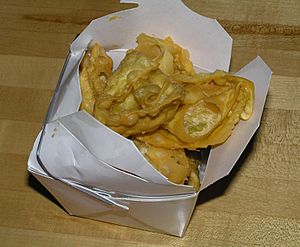
American Chinese cuisine makes use of ingredients not native to and very rarely used in China. One such example is the common use of Western broccoli (Chinese: 西蘭; pinyin: xīlán) instead of Chinese broccoli (Gai-lan, Chinese: 芥蘭; pinyin: jièlán) in American Chinese cuisine. Occasionally, Western broccoli is also referred to as sai1 laan4 fa1 in Cantonese (Chinese: 西蘭花) in order not to confuse the two styles of broccoli. Among Chinese speakers, however, it is typically understood that one is referring to the leafy vegetable unless otherwise specified.
This is also the case with the words for carrot (luo buo or lo baak, or hong luo buo, hong meaning "red") and onion (yang cong). Lo baak, in Cantonese, can refer to several types of rod-shaped root vegetable including carrot, daikon, green radish, or an umbrella term for all of them. The orange Western carrot is known in some areas of China as "foreign radish" (or more properly hung lo baak in Cantonese, hung meaning "red").
When the word for onion, cong, is used, it is understood that one is referring to "green onions" (otherwise known to English-speakers as "scallions" or "spring onions"). The larger, many-layered onion bulb common in the United States is called yang cong. This translates as "foreign onion". These names make it evident that the American broccoli, carrot, and onion are not indigenous to China, and therefore are less common in the traditional cuisines of China.
Egg fried rice in American Chinese cuisine is also prepared differently, with more soy sauce added for more flavor whereas the traditional egg fried rice uses less soy sauce. Some food styles, such as dim sum, were also modified to fit American palates, such as added batter for fried dishes and extra soy sauce.
Salads containing raw or uncooked ingredients are rare in traditional Chinese cuisine, as are Japanese style sushi or sashimi. However, an increasing number of American Chinese restaurants, including some upscale establishments, have started to offer these items in response to customer demand.
Ming Tsai, the owner of the Blue Ginger restaurant in Wellesley, Massachusetts, and host of PBS culinary show Simply Ming, said that American Chinese restaurants typically try to have food representing 3-5 regions of China at one time, have chop suey, or have "fried vegetables and some protein in a thick sauce", "eight different sweet and sour dishes", or "a whole page of 20 different chow meins or fried rice dishes". Tsai said "Chinese-American cuisine is 'dumbed-down' Chinese food. It's adapted... to be blander, thicker and sweeter for the American public".
Most American Chinese establishments cater to non-Chinese customers with menus written in English or containing pictures. If separate Chinese-language menus are available, they typically feature items such as liver, chicken feet, or other meat dishes that might deter American customers. In Chinatown, Manhattan, some restaurants are known for having a "phantom" menu with food preferred by ethnic Chinese, but believed to be disliked by non-Chinese Americans.
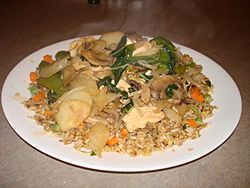
Dishes
Dishes that often appear on American Chinese restaurant menus include:
- Almond chicken—chicken breaded in batter containing ground almonds, fried and served with almonds and onions.
- Beef & broccoli—flank steak cut into small pieces, stir fried with broccoli, and covered in a dark sauce made with soy sauce and oyster sauce and thickened with cornstarch.
- Chicken & broccoli—similar to beef & broccoli, but with chicken instead of beef.
- Chinese chicken salad—usually containing sliced or shredded chicken, uncooked leafy greens, crispy noodles (or fried wonton skins) and sesame dressing. Some restaurants serve the salad with mandarin oranges.
- Chop suey—connotes "assorted pieces" in Chinese. It is usually a mix of vegetables and meat in a brown sauce but can also be served in a white sauce.
- Crab rangoon—fried wonton skins stuffed with (usually) artificial crab meat (surimi) and cream cheese.
- Fortune cookie—invented in California as a Westernized version of the Japanese omikuji senbei, fortune cookies have become sweetened and found their way to many American Chinese restaurants.
- Fried wontons—somewhat similar to crab rangoon, a filling, (most often pork), is wrapped in a wonton skin and deep fried.
- General Tso's chicken—chunks of chicken that are dipped in batter, deep fried, and seasoned with ginger, garlic, sesame oil, scallions, and hot chili peppers. Believed to be named after Qing Dynasty statesman and military leader Zuo Zongtang, often referred to as General Tso.
- Mongolian beef—fried beef with scallions or white onions in a spicy and often sweet brown sauce.
- Pepper steak—sliced steak, green bell peppers, tomatoes, and white or green onions stir fried with salt, sugar, and soy sauce. Bean sprouts are a less common addition.
- Royal beef—deep-fried sliced beef, doused in a wine sauce and often served with steamed broccoli.
- Sesame chicken—boned, marinated, battered, and deep-fried chicken which is then dressed with a translucent red or orange, sweet and mildly spicy sauce, made from soy sauce, corn starch, vinegar, chicken broth, and sugar.
- Sushi—despite being served in the Japanese and American styles, some American Chinese restaurants serve various types of sushi, usually on buffets.
- Sweet roll—yeast rolls, typically fried, covered in granulated sugar or powdered sugar. Some variants are stuffed with cream cheese or icing.
- Wonton strips—commonly served complimentary along with duck sauce and hot mustard, or with soup when ordering take-out.
Other American Chinese dishes
Authentic restaurants with Chinese-language menus may offer "yellow-hair chicken" (Chinese: 黃毛雞; Mandarin Pinyin: huángmáo jī; Jyutping: wong4 mou4 gai1; literally "yellow-feather chicken"), essentially a free-range chicken, as opposed to typical American mass-farmed chicken. Yellow-hair chicken is valued for its flavor, but needs to be cooked properly to be tender due to its lower fat and higher muscle content. This dish usually does not appear on the English-language menu.
Dau miu (Chinese: 豆苗; pinyin: dòumiáo) is a Chinese vegetable that has become popular since the early 1990s, and now not only appears on English-language menus, usually as "pea shoots", but is often served by upscale non-Asian restaurants as well. Originally it was only available during a few months of the year, but it is now grown in greenhouses and is available year-round.
North American versions of dishes also found in China
- Beijing beef—in China, this dish uses gai lan (Chinese broccoli) rather than American broccoli.
- Cashew chicken—stir-fried tender chicken pieces with cashews.
- Chow mein—literally means "stir-fried noodles". Chow mein consists of fried crispy noodles with bits of meat and vegetables. It can come with chicken, pork, shrimp or beef.
- Egg foo young—a Chinese-style omelet with vegetables and meat, usually served with a brown gravy. While some restaurants in North America deep fry the omelet, versions found in Asia are more likely to fry in the wok.
- Egg roll—while spring rolls have a thin, light beige crispy skin that flakes apart, and is filled with mushrooms, bamboo, and other vegetables inside, the American-style egg roll has a thicker, chewier, dark brown bubbly skin stuffed with cabbage and usually bits of meat or seafood (such as pork or shrimp), but no egg.
- Fried rice—fried-rice dishes are popular offerings in American Chinese food due to the speed and ease of preparation and their appeal to American tastes.
- Fried rice is generally prepared with rice cooled overnight, allowing restaurants to put leftover rice to good use (freshly cooked rice is actually less suitable for fried rice).
- The Chinese-American version of this dish typically uses more soy sauce than the versions found in China.
- Fried rice is offered with different combinations of meat (pork, chicken and shrimp are the most popular) and vegetables.
- Ginger beef (Chinese: 生薑牛肉; pinyin: shēngjiāng niúròu)—tender beef cut in chunks, mixed with ginger and Chinese mixed vegetables.
- Ginger fried beef (Chinese: 乾炒牛肉絲; pinyin: gānchǎo niúròu-sī)—tender beef cut in strings, battered, deep fried, then re-fried in a wok mixed with a sweet sauce, a variation of a popular Northern Chinese dish.
- Hulatang—a traditional Chinese soup with hot spices, often called "spicy soup" on menus.
- Kung Pao chicken—the Sichuan dish is spicy hot, but the versions served in North America tend to be less spicy if at all, and sometimes leave out the Sichuan pepper that is fundamental to the original dish.
- Lo mein ("stirred noodles")—frequently made with eggs and flour, making them chewier than simply using water. Thick, spaghetti-shaped noodles are pan fried with vegetables (mainly bok choy and Chinese cabbage [napa]) and meat. Sometimes this dish is referred to as chow mein (which literally means "stir-fried noodles" in Cantonese).
- Mei Fun—noodles usually simmered in broth with other ingredients such as fish balls, beef balls, and/or fish slices.
- Moo shu pork—the original version uses more typically Chinese ingredients (including wood ear fungi and daylily buds) and thin flour pancakes, while the American version uses vegetables more familiar to Americans, and thicker pancakes. This dish is quite popular in Chinese restaurants in the United States, but not so popular in China.
- Orange chicken—chopped, battered, fried chicken with a sweet orange flavored chili sauce that is thickened and glazed. The traditional version consists of stir-fried chicken in a light, slightly sweet soy sauce flavored with dried orange peels.
- Wonton soup—In most American Chinese restaurants, only wonton dumplings in broth are served, while versions found in China may come with noodles.
- In Canton, it can be a full meal in itself, consisting of thin egg noodles and several pork and prawn wontons in a pork or chicken soup broth or noodle broth. Especially in takeout restaurants, wonton are often made with thicker dough skins.
Regional variations
New York City
The New York metropolitan area is home to Chinese residents representing the largest Chinese population outside of Asia, constituting the largest metropolitan Asian-American group in the United States, and the largest Asian-national metropolitan diaspora in the Western Hemisphere. The Chinese-American population of the New York City metropolitan area was an estimated 893,697 as of 2017.
Given the New York metropolitan area's status as the leading gateway for Chinese immigrants to the United States—greater than San Francisco and Los Angeles combined—all popular styles of regional Chinese cuisine have commensurately become ubiquitously accessible in New York City, including Hakka, Taiwanese, Shanghainese, Hunanese, Szechuan, Cantonese, Fujianese, Xinjiang, Zhejiang, and Korean Chinese cuisine. Even the relatively obscure Dongbei style of cuisine indigenous to Northeast China is now available in Flushing, Queens, as well as Mongolian cuisine and Uyghur cuisine.
The availability of regional variations of Chinese cuisine coming from so many provinces of China is most apparent in the city's Chinatowns in Queens, particularly the Flushing Chinatown (法拉盛華埠), but is also notable in the city's Chinatowns in Brooklyn and Manhattan.
Kosher preparation of Chinese food
Kosher preparation of Chinese food is also widely available in New York City, given the metropolitan area's large Jewish and particularly Orthodox Jewish populations.
The perception that American Jews eat at Chinese restaurants on Christmas Day is documented in media. The tradition may have arisen from the lack of other open restaurants on Christmas Day, the close proximity of Jewish and Chinese immigrants to each other in New York City, and the absence of dairy foods combined with meat.
Kosher Chinese food is usually prepared in New York City, as well as in other large cities with Orthodox Jewish neighborhoods, under strict rabbinical supervision as a prerequisite for Kosher certification.
Los Angeles County
Chinese populations in Los Angeles represent at least 21 of the 34 provincial-level administrative units of China, making greater Los Angeles home to a diverse population of Chinese people in the United States.
Chinese-American cuisine in the Greater Los Angeles area is concentrated in Chinese ethnoburbs rather than traditional Chinatowns. The oldest Chinese ethnoburb is Monterey Park, considered to be the nation's first suburban Chinatown.
Although Chinatown in Los Angeles is still a significant commercial center for Chinese immigrants, the majority have relocated to the areas with significant Chinese-immigrant populations in the San Gabriel Valley, stretching from Monterey Park into the cities of Alhambra, San Gabriel, Rosemead, San Marino, South Pasadena, West Covina, Walnut, City of Industry, Diamond Bar, Arcadia, and Temple City.
The Valley Boulevard corridor is the main artery of Chinese restaurants in the San Gabriel Valley. Another hub with a significant Chinese population is Irvine (Orange County). More than 525,000 Asian Americans live in the San Gabriel Valley alone, with over 67% being foreign born. The valley has become a brand-name tourist destination famous in China. Of the ten cities in the United States with the highest proportions of Chinese Americans, the top eight are located in the San Gabriel Valley, making it one of the largest concentrated hubs for Chinese Americans in North America.
Some regional styles of Chinese cuisine include Beijing, Chengdu, Chonqing, Dalian, Hangzhou, Hong Kong, Hunan, Mongolian hot pot, Nanjing, Shanghai, Shanxi, Shenyang, Wuxi, Xinjiang, Yunnan, and Wuhan.
San Francisco Bay Area
Since the early 1990s, many American Chinese restaurants influenced by California cuisine have opened in the San Francisco Bay Area. The trademark dishes of American Chinese cuisine remain on the menu, but there is more emphasis on fresh vegetables, and the selection is vegetarian-friendly.
This new cuisine has exotic ingredients like mangos and portobello mushrooms. Brown rice is often offered as an alternative to white rice.
Some restaurants substitute grilled wheat flour tortillas for the rice pancakes in mu shu dishes. This occurs even in some restaurants that would not otherwise be identified as California Chinese, both the more Westernized places and the more authentic places. There is a Mexican bakery that sells some restaurants thinner tortillas made for use with mu shu. Mu shu purists do not always react positively to this trend.
In addition, many restaurants serving more native-style Chinese cuisines exist, due to the high numbers and proportion of ethnic Chinese in the San Francisco Bay Area.
Restaurants specializing in Cantonese, Sichuanese, Hunanese, Northern Chinese, Shanghainese, Taiwanese, and Hong Kong traditions are widely available, as are more specialized restaurants such as seafood restaurants, Hong Kong-style diners and cafes, also known as Cha chaan teng (Chinese: 茶餐廳; pinyin: chácāntīng), dim sum teahouses, and hot pot restaurants. Many Chinatown areas also feature Chinese bakeries, boba milk tea shops, roasted meat, vegetarian cuisine, and specialized dessert shops.
Chop suey is not widely available in San Francisco, and the area's chow mein is different from Midwestern chow mein.
Boston
Chinese cuisine in Boston results from a combination of economic and regional factors. The growing Boston Chinatown accommodates Chinese-owned bus lines shuttling an increasing number of passengers to and from the numerous Chinatowns in New York City, and this has led to some exchange between Boston Chinese cuisine and that in New York.
A large immigrant Fujianese immigrant population has made a home in Boston, leading to Fuzhou cuisine being readily available there. An increasing Vietnamese population has also had an influence on Chinese cuisine in Greater Boston.
Finally, innovative dishes incorporating chow mein and chop suey as well as locally farmed produce and regionally procured seafood are found in Chinese as well as non-Chinese food in and around Boston.
Joyce Chen introduced northern Chinese (Mandarin) and Shanghainese dishes to Boston in the 1950s, including Peking duck, moo shu pork, hot and sour soup, and potstickers, which she called "Peking Ravioli" or "Ravs". Her restaurants would be frequented by early workers on the ARPANET, John Kenneth Galbraith, James Beard, Julia Child, Henry Kissinger, Beverly Sills, and Danny Kaye. A former Harvard University president called her eating establishment "not merely a restaurant, but a cultural exchange center".
Philadelphia
The evolving American Chinese cuisine scene in Philadelphia has similarities with the situation in both New York City and Boston. As with Boston, Philadelphia is experiencing significant Chinese immigration from New York City, 95 miles to the north, and from China, the top country of birth by a significant margin for a new arrivals there .
There is a growing Fujianese community in Philadelphia as well, and Fuzhou cuisine is readily available in the Philadelphia Chinatown. Also, emerging Vietnamese cuisine in Philadelphia is contributing to evolution in local Chinese cuisine, with some Chinese-American restaurants adopting Vietnamese influences or recipes.
Hawaii
Hawaiian-Chinese food developed somewhat differently from Chinese cuisine in the continental United States.
Owing to the diversity of Pacific ethnicities in Hawaii and the history of the Chinese influence in Hawaii, resident Chinese cuisine forms a component of the cuisine of Hawaii, which is a fusion of different culinary traditions. Some Chinese dishes are typically served as part of plate lunches in Hawaii.
The names of foods are different as well, such as Manapua, from the Hawaiian contraction of "Mea ono pua'a" or "delicious pork item" from the dim sum bao, though the meat is not necessarily pork.
Other regional American Chinese dishes
- Chow mein sandwich—sandwich of chow mein and gravy (Southeastern Massachusetts; Rhode Island)
- Chop suey sandwich—sandwich of chicken chop suey on a hamburger bun (North Shore of Massachusetts)
- St. Paul sandwich—egg foo young patty in plain white sandwich bread (St. Louis, Missouri)
- Springfield-style cashew chicken—a style of cashew chicken that combines breaded deep-fried chicken, cashews, and oyster sauce (Springfield, Missouri)
- War/wor sue gai (boneless almond chicken)—bite-sized Southern-style fried chicken with yellow sauce (Columbus, Ohio)
- Yaka mein—Chinese-Creole food found in New Orleans that evolved from beef noodle soup
Images for kids
-
A typical Panda Express meal: Kung Pao chicken, orange chicken, chow mein and steamed vegetables
See also
 In Spanish: Gastronomía sinoestadounidense para niños
In Spanish: Gastronomía sinoestadounidense para niños


